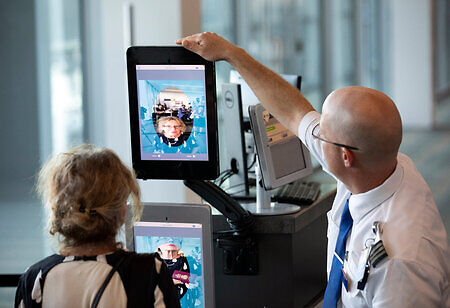
What's the Present and Future of Facial Recognition Technology?


Facial recognition technology (FRT) was initially publicized by movies such as ‘A Space Odyssey.' Today, it has become an inevitable part of our everyday life. Be it walking through hospitals, crossing the streets, passing through security checks at various shopping and public stops, or even the smartphone. Mordor Intelligence’s market report predicts that the Facial Recognition market is expected to land a valuation of $ 11.62 billion by 2026 at a 21.71 percent CAGR.
Due to COVID-19, several FRT companies have upgraded their algorithms to sync with the latest norms and changes regulated by their respective countries’ governments. In fact, the National Institute of Standards and Technology (NIST) found that the algorithms that were reconfigured since the pandemic make fewer mistakes when recognizing masked individuals. In some cases, the error rates proved to be ten times better than before. How these technologies work is a first step to consider before checking its applicative value and the ups and downs that are reported about this technology.
How are Faces Recognized?
It’s clearly easier to recognize the face of a family member, friend, or acquaintance since their features are already registered in the concerned person’s mind. That is exactly how FRT works, but with the major help of algorithms. Similar to how a person sees a face, this technology instead sees the data.
The method of employing ‘biometrics,’ that is, an individual's physical features, to digitally map an individual's facial ‘geometry,’ such as the distance between an individual's eyes, his or her forehead and chin, and the width of his or her nose, is known as facial recognition technology. These measurements are then used to produce a ‘facial template’ or ‘facial signature,’ which is a mathematical formula. The physical structure of an individual's face is then compared to this recorded template or signature to validate their identity or uniquely identify that individual.
While companies upgrade their algorithms for FRT, most have turned to deploying artificial intelligence (AI), which is transforming the way we can use this technology and the benefits to draw from it.
AI taking FRT to New Levels
Security Check
FRT powered by AI can assist detect suspicious behavior, tracking down known offenders, and keeping people safe in crowded places. Furthermore, facial recognition technology improves the convenience and security of everyday activities such as banking, healthcare, and shopping. It may make entering places of business more secure, assist in avoiding all sorts of fraud, and make internet services safer.
Easy Business
Businesses can make it easier for their customers to access their services by replacing current customer identification systems with facial recognition. The technology can also help with the move to digital-first experiences by removing the requirement for customers to be physically present at a location in order to receive services, which is particularly useful in the aftermath of the epidemic.
Quality Customer Service
Facial recognition, as a continuation of the previous point, aids in improving customer service quality, particularly in retail and healthcare. Knowing who visits a store and their purchasing history, for example, allows retailers to alter their offers on the fly to better fit the demands of the customer. Facial recognition can also help healthcare providers create tailored treatment plans and serve patients faster.
More Flexible Service for the Visually Impaired
Facial recognition is also often used by people with vision impairments. Using facial recognition to power your business can also make your services more accessible. A visually handicapped consumer, for example, may let their face be scanned and use a service instead of going through verification steps like inputting a PIN or filling out paperwork.
However, FRT is not considered to be entirely flawless. Over the years, this technology has been considered to be biased against women and people of color. However, some of these claims come from the early stages of the technology, which was just emerging. More or less, algorithms are merely tools that may or may not be accurate. Like any tool, technologies are dynamic, and there are more ways for improvement than one.
Privacy
Citizens' fundamental right to be under constant government monitoring and have their photographs kept without their consent is violated by facial recognition. Face recognition privacy concerns revolve around unprotected data storage techniques that could disclose facial recognition data as well as other security threats. Most businesses continue to store their facial data on local computers, exposing them to security risks and a scarcity of IT security experts to assure network security.
When data is stored in the cloud, facial recognition technology can offer optimal data security. Data integrity, on the other hand, can only be ensured with effective encryption. IT cybersecurity personnel must be deployed to ensure adequate data storage and consumer control in order to promote accountability and avoid unwanted traffic.
Tech giants have also imposed certain restrictions or ways of making the public aware of suing FRT.
IBM is Strong in the Export of FRT
For federal regulation in the US, tech giant IBM set significant restrictions on its FRT sales. Furthermore, IBM made explicit recommendations to the US Department of Commerce to implement stronger export limits on facial recognition systems in select cases.
Microsoft is Advising Public of the Transparency
Microsoft is advocating for new legislation to address issues such as transparency and third-party testing and comparison. Microsoft advises that tech companies provide documentation and facial recognition services to define the technology's capabilities and limitations in order to promote transparency.
Amazon is Strict with the Safety
Amazon put a one-year moratorium on law enforcement using their ‘Amazon Rekognition’ facial recognition technology in 2020. Amazon has also proven its application in public safety and law enforcement settings in order to filter down possible matches.
Amazon has also filed a patent application to investigate additional authentication levels for ultimate security. Users are asked to do things like smile, blink, and tilt their heads, among other things.